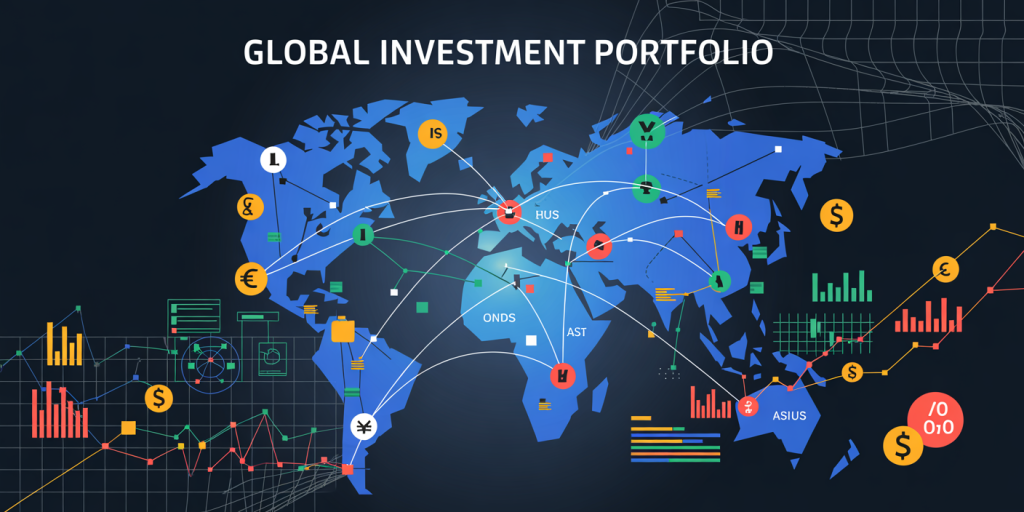How Multimarket Funds Work and Who Should Invest in Them
In an increasingly globalized world, investors seek diversified opportunities that span across different regions and asset classes. Multimarket funds have emerged as a strategic choice for those looking to benefit from varied markets while managing risk effectively. By combining investments in multiple geographic regions and asset sectors, these funds aim to provide balanced growth and income potential. Understanding how multimarket funds function and identifying who stands to gain most from them is essential for making informed investment decisions.
Understanding Multimarket Funds: What Makes Them Unique
Multimarket funds, also known as global or international balanced funds, invest across various asset classes such as equities, bonds, and cash instruments while spanning multiple countries and industries. Unlike traditional funds that may focus solely on stocks or bonds within a particular country, these funds diversify geographically and by asset type. This diversification can help reduce volatility and capitalize on growth opportunities worldwide.

Imagem ilustrativa: A dynamic global investment portfolio concept showing diverse asset classes like equities, bonds, and cash instruments distributed across multiple continents including the U.S., Europe, Asia, and emerging markets, with financial charts and currency symbols overlayed.
For example, a typical multimarket fund might allocate 40% of its portfolio to U.S. equities, 30% to emerging market bonds, 20% to European stocks, and 10% to cash or money market instruments. This blend allows investors to benefit from robust economic sectors in different regions, such as technology stocks in the U.S., industrial growth in Asia, or sovereign bonds from Europe. The ability to shift allocations based on market conditions adds flexibility to multimarket funds, as portfolio managers react to global economic indicators and geopolitical events.
A practical case illustrating multimarket funds’ benefits is the growth experienced during periods when certain markets outperform others. For instance, during 2019, the MSCI Emerging Markets Index rose by approximately 18%, while many developed markets saw comparatively modest gains. Investors in multimarket funds that had exposure to emerging markets benefited from this upswing without being fully exposed to the volatility typical of single-market funds.
How Multimarket Funds Operate: Portfolio Construction and Management
Multimarket funds rely heavily on active management, where fund managers continually analyze global economic trends, interest rates, currency fluctuations, and political risks to adjust the fund’s holdings. The flexibility to move between asset classes and regions enables multimarket funds to adapt quickly to changing investment landscapes.

Imagem ilustrativa: An active fund manager analyzing global economic trends and geopolitical risks in a modern office, surrounded by multiple screens displaying world maps, stock market data, interest rates, and currency exchange rates.
The portfolio construction begins with broad asset allocation decisions based on macroeconomic analysis. Managers evaluate regions such as North America, Europe, Asia, and Latin America to determine which economies show strong fundamentals. Then, within these regions, they decide the mix of equities, fixed income, and other securities. For instance, during periods of rising interest rates, managers might reduce bond exposure in favor of equities or cash equivalents to mitigate risk.
To demonstrate the dynamic nature of these funds, consider the period between 2020 and 2023. In early 2020, many multimarket fund managers increased exposure to bonds to hedge against the economic shocks caused by the COVID-19 pandemic. Later, as recovery signals emerged, they shifted allocations toward stocks, including technology and consumer sectors in the U.S. and Asia. This active rebalancing took advantage of opportunities while managing downside risk.
A comparative table below outlines a sample asset allocation strategy from two hypothetical multimarket funds:
Asset Class Fund A Allocation (%) Fund B Allocation (%)
U.S. Equities 40 35
Emerging Market Equities 25 30
European Bonds 20 15
Cash & Money Market 15 20
Fund A adopts a slightly more aggressive equity stance, while Fund B opts for a more conservative position with higher cash holdings for liquidity.
Benefits of Investing in Multimarket Funds
One of the primary advantages of multimarket funds is diversification. By spreading investments across multiple regions and asset classes, these funds reduce the risk associated with any single market downturn. Diversification is a well-established strategy for mitigating portfolio risk, with studies showing that international diversification can reduce portfolio volatility by up to 25% compared to domestic-only portfolios (Source: Morningstar, 2022).
Another significant benefit is professional management. Multimarket funds are managed by experienced portfolio managers who use comprehensive research and global insights to optimize returns. This expertise is especially valuable given the complexity of navigating foreign markets, currency risks, and geopolitical challenges.
Additionally, multimarket funds offer convenience. Instead of investing in separate foreign equities, bonds, and other instruments, investors gain access to a broad array of assets through a single fund, simplifying portfolio management and reducing transaction costs.
For example, an individual investor interested in tapping into both the U.S. tech sector and Asian emerging markets faces challenges like market access, currency exchange, and regulatory barriers. Investing in a multimarket fund eliminates these hurdles while providing professional oversight.
Potential Risks and Limitations of Multimarket Funds
Despite their advantages, multimarket funds carry inherent risks that investors must consider. Currency risk is a primary concern as fluctuations in exchange rates can affect returns negatively, particularly if the investor’s home currency appreciates against the currencies in the fund’s portfolio.
Geopolitical risk is another factor. Changes in government policies, trade tensions, or political instability can impact certain regions disproportionately. For instance, the U.S.-China trade war from 2018 to 2020 created volatility across Asian markets, which multimarket fund managers had to navigate carefully.
Another limitation is management fees. Active management and the need to research and trade global securities often result in higher fees compared to domestic, single-market index funds. According to a 2023 report by Lipper, the average expense ratio for multimarket funds is approximately 1.25%, while comparable U.S. equity index funds average 0.10%. Over time, higher fees can significantly reduce net returns, especially in low-growth environments.
Moreover, performance can be inconsistent due to the complex balancing act between different markets and asset classes. Investors may find that during booming markets in one country, their multimarket fund underperforms more focused equity funds.
Who Should Consider Investing in Multimarket Funds?
Multimarket funds are particularly suitable for investors seeking broad diversification while maintaining a relatively hands-off investment style. They appeal to individuals who want global exposure but lack the time or expertise to manage a complex international portfolio themselves.
These funds are also ideal for moderate-risk investors. Since they allocate across stocks, bonds, and cash globally, their risk profile is typically intermediate between pure equity funds and conservative bond funds. For example, a 45-year-old investor planning for retirement in 20 years might invest in multimarket funds to balance growth potential and risk mitigation.
Another group that benefits includes retirees or income-focused investors who desire steady but diversified income sources from different regions’ bond markets and dividend-paying stocks. Multimarket funds can provide stable distributions by investing in government bonds from developed countries coupled with high-dividend equities in emerging markets.
However, aggressive investors who prefer maximum capital appreciation through U.S.-centric tech stocks or those with a high-risk tolerance might find multimarket funds too conservative or diluted. Conversely, highly risk-averse investors might prefer fixed-income-only domestic funds to avoid currency and geopolitical uncertainties inherent in multimarket investing.
Consider an investor profile comparison:
Investor Type Risk Tolerance Investment Horizon Suitability for Multimarket Funds
Young Growth-Oriented High 20+ years Moderate (may prefer concentrated equity funds)
Mid-Life Balanced Moderate 10-20 years High
Retiree/Income-Focused Low to Moderate Under 10 years Moderate to High
Conservative Investor Low Any Low (may avoid currency risk)
Future Perspectives on Multimarket Fund Investing
Looking ahead, multimarket funds are likely to become even more important as globalization and interconnected markets evolve. The integration of emerging economies with developed markets can create new growth opportunities and further diversification benefits. According to the International Monetary Fund (IMF) projections as of 2024, emerging markets are expected to grow at an average annual GDP rate of 4.5% over the next decade, outpacing developed economies significantly.
Technological advancements in data analytics and artificial intelligence are enhancing fund managers’ ability to predict macroeconomic trends and asset correlations more accurately, potentially improving multimarket funds’ performance. Alongside this, growing investor demand for Environmental, Social, and Governance (ESG)-focused investments is reshaping portfolios with a global lens, encouraging multimarket funds to incorporate sustainable assets worldwide.
At the same time, geopolitical challenges, such as trade disputes and regulatory changes, will require continued vigilance and agility from fund managers. Investors who prioritize multimarket funds must monitor global economic shifts, currency risks, and political developments carefully.
In conclusion, multimarket funds offer a powerful diversification tool for investors pursuing balanced growth and income options beyond their domestic markets. They combine professional active management with geographic and asset-class diversity, cushioning investors from concentrated risks while capturing global opportunities. With appropriate risk tolerance and financial goals, multimarket funds can serve as a core component in diversified investment strategies geared for the future.
Imagem ilustrativa: A diverse group of investors representing different life stages and risk profiles—young growth-oriented, mid-life balanced, retiree/income-focused—each with visual icons indicating their investment horizon and suitability for multimarket funds, set against a backdrop of global financial markets.

